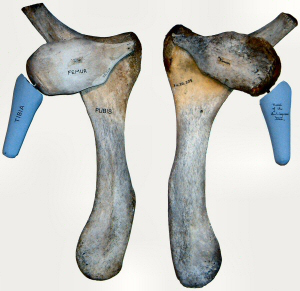What the ? @DCSCCC ?!
If you go back into the fossil whale record … you will see whales and proto-whales with all sorts of combinations of limbs … This is because mammals had 4 limbs… and it can sometimes take more than millions of years to genetically lose something you don’t need.
The point that was raised in this thread is that some MODERN WHALES have under-developed femurs that are completely buried in their tissues … so they don’t exist for swimming or mating or anything. They are just laying their dormant … because there was a time in whale gene pools when they NEEDED their rear limbs.
QUOTE 1:
The existence of a pair of small pelvic bones is known to exist in nearly all of the Cetacea, lying far apart from the vertebral column on both sides of the genital opening.
However, in the Fin Whale, the Blue Whale, and the Humpback, the femur too is present near the pelvis. [Even in the Sperm Whale the femur is sometimes present (in the form of a small round-shaped bone near the pelvis). - E.T.B.]
And in the Right Whale not only the femur but also the tibia exists. Of course these bones are buried deeply under the skin, causing no protuberance on the body surface."
[Quote from Ogawa, R., and Kamiya, T. A. (1957) “Case of the Cachalot [Sperm Whale] With Protruded Rudimentary Hind Limbs.” Scientific Reports of the Whales Research Insititute, No. 12, p. 197-208.]
QUOTE 2:
Hind Limb Rudiments on Modern Whales Example Five
HIND LIMB RUDIMENTS FOUND ON MODERN DAY WHALES
“Nothing can be imagined more useless to the animal than rudiments of hind legs entirely buried beneath the skin of a whale, so that one is inclined to suspect that these structures must admit of some other interpretation. Yet, approaching the inquiry with the most skeptical determination, one cannot help being convinced, as the dissection goes on, that these rudiments [in the Right Whale] really are femur and tibia.”
“The synovial capsule representing the knee-joint was too evident to be overlooked. An acetabular cartilage, synovial cavity, and head of femur, together represent the hip-joint. Attached to this femur is an apparatus of constant and strong ligaments, permitting and restraining movements in certain directions; and muscles are present, some passing to the femur from distant parts, some proceeding immediately from the pelvic bone to the femur, by which movements of the thigh-bone are performed; and these ligaments and muscles present abundant instances of exact and interesting adaptation. But the movements of the femur are extremely limited, and in two of these whales the hip-joint as firmly anchylosed, in one of them on one side, in the other on both sides, without trace of disease, showing that these movements may be dispensed with. The function point of view fails to account for the presence of a femur in addition to processes from the pelvic bone. Altogether, these hind legs in this whale present for contemplation a most interesting instance of those significant parts in an animal – rudimentary structures.” [Struthers, p. 142-143]
[Struthers, John, M.D., Professor of Anatomy in the University of Aberdeen. (1881) “On the Bones, Articulations, and Muscles of The Rudimentary Hind-Limb of the Greenland Right-Whale (Balaena mysticetus).”]



